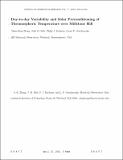Day-to-day variability and solar preconditioning of thermospheric temperature over Millstone Hill
Author(s)
Zhang, Shun-Rong; Holt, John M; Erickson, Philip J; Goncharenko, Larisa
DownloadMainarticle (1.627Mb)
PUBLISHER_POLICY
Publisher Policy
Article is made available in accordance with the publisher's policy and may be subject to US copyright law. Please refer to the publisher's site for terms of use.
Terms of use
Metadata
Show full item recordAbstract
We use a continuous 30 day incoherent scatter radar experiment at Millstone Hill in October 2002 to examine day-to-day thermospheric variability in exospheric temperature T[subscript ex]. Solar flux and magnetic activity influences as the main driving factors for day-to-day variability are investigated quantitatively. Solar ultraviolet flux levels are based on the TIMED/SEE space weather product, allowing for analysis of ultraviolet flux-T[subscript ex] correlation. T[subscript ex] is most sensitive to solar EUV flux with approximately a 2 day delay at wavelengths of 27–34 nm (including 30.4 nm). In particularly, a 20–60 h time delay occurs in T[subscript ex] response to EUV flux at 27–34 nm band, with shorter delays in the morning and longer delays in the afternoon and at night. The 1 ∼ 2 day delayed T[subscript ex] response to solar ultraviolet flux and associated thermospheric solar preconditioning (“memory”) are most significant in the daily mean for the 27–34 nm band, in the diurnal and semidiurnal amplitudes for the soft X-ray flux at 0.1–7 nm, and in the diurnal amplitude for longer wavelengths. An empirical model driven only by EUV flux at 27–34 nm from 2 days in advance reproduces 90% of the observed variability in the Tex daily mean. With a 2 day time delay, solar X-ray flux at 0.1–7 nm is correlated positively with T[subscript ex] diurnal amplitude and negatively with T[subscript ex] semidiurnal amplitude. Finally, magnetic activity control, as represented by the Dst index, is weaker during the day and stronger at night and is important for the semidiurnal amplitude but not important for the daily mean.
Date issued
2015-05Department
Haystack ObservatoryJournal
Journal of Geophysical Research: Space Physics
Publisher
American Geophysical Union (AGU)
Citation
Zhang, Shun-Rong et al. “Day-to-Day Variability and Solar Preconditioning of Thermospheric Temperature over Millstone Hill: THERMOSPHERIC VARIABILITY AND MEMORY.” Journal of Geophysical Research: Space Physics 120.5 (2015): 3913–3927.
Version: Author's final manuscript
ISSN
21699380
2169-9380